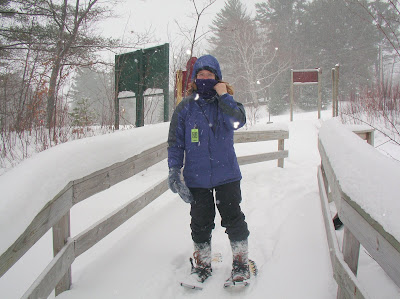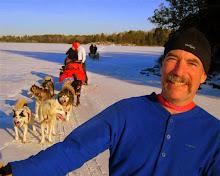Bought me a pair of cowhide boots, to be prepared for winter walks. The shoemaker praised them because they were made a year ago. I feel like an armed man now. The man who has bought his boots feels like him who has got in his winter’s wood. There they stand beside me in the chamber, expectant, dreaming of far woods and wood-paths, of frost-bound or slushy roads, of being bound with skate-traps and clogged with ice-dust. H.D. Thoreau, Journal, Dec.3, 1856
I also got a new pair of boots - mukluks to fit the environment that I like to be in. Though not indigenous to the north woods hereabout, with their rubber soles they do quite nicely on those days when the temperature rises to thaw. .I have always felt good in a pair of soft soled boots in the winter time. I got my dad's Maine hunting shoes, a soft soled rubber bottom leather topped boot when I was in junior high school, that I would wear in the woods and on my paper route that I walked in the winter. They were (and still are) made in Maine by LL Bean and are very serviceable for wet fall conditions and in winter, if it isn't too cold.
When I went to Alaska I started wearing Nunamiut - made kamiks, made of caribou hide, with the fur turned in (caribou bull neck hide) for the sole and the upper portion of the boot from the caribou leg with the fur turned out. Light and very warm; not to be used above zero Fahrenheit or else the moisture woild degrade the skin and it would rip. Many spinoffs to the Inuit "mukluk" have been devised, also native tanned moccasins - all originals and later models are light and warm due to their flexibility. Denny Akeya, a St Lawrence Island Siberian Yupic told me that he quit being able to wear their sealskin mukluks, though he wished that he could, because as he became an adult, his weight on his feet didn't give him enough support with mukluks. Fortunately I never had that problem.
Lynn would make smoke tanned moose hide bottom and unbleached canvas top mukluks and moccasins when we lived in Eagle. They looked a bit like the Steger mukluks that are in the picture. I bought this pair last year in the Steger Store in Ely, during a sale that they were having. The advantage with these mukluks is that they have commercially tanned moose hide that , though less porous and insulating than smoke tanned, is more durable and the rubber bottoms are grippy and not affected by wet conditions. With a wool felt liner, they are warm, flexible (which keeps the foot warm and comfortably circulating) and with good traction.
A friend of mine who I guided dog team trips with, Scott N. once, in a late season trip, got his Steger mukluks thoroughly soaked for 3 days in rain. The mukluks were none the worse for wear and his feet did O K too. By the end of that trip we were mushing on bare ground!
I still have my old Steger's that I got while I was living in Eagle. Though worn, they are still serviceable. They have a shorter canvas top which is handy and serviceable.I have to keep sole saver coating, a rubber cement-like substance brushed on them after letting a dog sled trip client with cold feet use them one below zero morning. I told her to keep them away from the camp fire, but she forgot and melted the rubber bottom and ever after they have been sticky unless the sole saver is applied to them. I got Lynn a pair like my old ones for winter treks and camps. Much warmer, lighter and less "clunky than Sorel pak boots.
Each year, since i lived in Anaktuvuk Pass, I feel much like Thoreau when it is time to get out the winter moccasins or mukluks. That sense of excitement to be wearing true boots of the north, Native designed and adapted for the northland.
I now have a pair of 3 season "wrap-around top" moccasins from Steger Co. that I've used for snowshoe use as well as using when the conditions are dry. On my feet the soft soles feel right.

Beside the Steger "Expedition" mukluks is one of my ski boots that are seeing a lot of use with the beautiful snows that we are now having.








